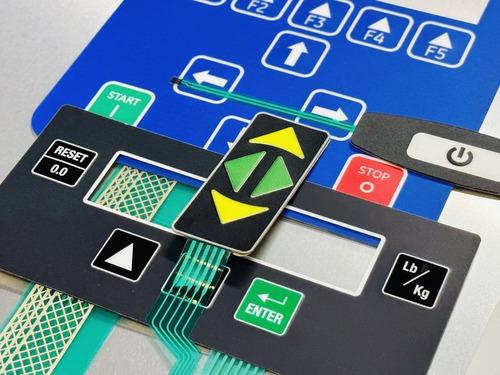Exactly How Membrane Switches Give Seamless Procedure in Harsh Atmospheres
Exactly How Membrane Switches Give Seamless Procedure in Harsh Atmospheres
Blog Article
The Ultimate Resource on Membrane Changes: Style, Capability, and Applications
Membrane changes serve as a fascinating intersection of design and functionality, playing a crucial function in modern customer interfaces across different industries. As we discover the diverse applications of membrane buttons, it becomes evident that their flexibility and durability are crucial in environments ranging from medical care to customer electronic devices.

Comprehending Membrane Buttons
Membrane switches are a kind of user interface innovation widely used in various digital devices, identified by their thin, adaptable layout and capability. These buttons contain multiple layers that include graphic overlays, glue layers, and wiring, making it possible for a portable and effective user interface for customers. They can be found in devices, clinical devices, and industrial control panels, supplying a trusted technique for customer communication.
Among the primary advantages of membrane switches is their capability to resist contaminants such as dirt and moisture, making them suitable for environments where longevity is vital. Their low-profile layout allows for smooth integration right into various applications, while the adjustable graphic overlays enhance user experience by providing clear aesthetic responses. Additionally, membrane layer switches can fit a variety of technologies, such as tactile feedback and backlighting, more improving their use.
The production procedure for membrane layer switches over commonly entails display lamination, printing, and die-cutting strategies, ensuring accuracy and consistency in manufacturing. Generally, membrane layer switches over stand for a flexible and reliable remedy for modern-day digital gadgets, combining capability with visual appeal in interface layout.
Key Parts and Layout Components
A selection of essential components and layout aspects collaborated to develop an efficient membrane switch. At the core, the graphic overlay serves both aesthetic and functional objectives, providing an easy to use user interface while protecting internal parts from environmental factors. The choice of materials, generally polyester or polycarbonate, affects durability and responsive feedback.
Below the overlay, the adhesive layer makes sure the button adheres safely to the substrate, which can be metal, glass, or plastic. The spacer layer is important, as it keeps the required void between the circuit and the overlay layers, permitting reliable actuation. Membrane Switches. Circuit traces, typically made from conductive ink or adhesive, are published on a flexible substrate, making it possible for electric signals to be transferred when stress is applied
Design considerations likewise include the setup of responsive domes or embossing that provide physical feedback to the customer, enhancing the overall experience. Furthermore, the format and spacing of the buttons must be enhanced for convenience of use, making sure that customers can browse the interface without effort. Overall, these components and design aspects function synergistically to develop a reputable, practical membrane switch tailored to particular applications.
Performance and Procedure Mechanism
At the heart of effective functionality for membrane changes exists their functional device, which facilitates user interaction with a basic yet effective design. These switches operate on the principle of pressure activation, where a user uses pressure to a marked location of the button (Membrane Switches). This action compresses the layers of the switch, completing an electric circuit that sends out a signal to the connected gadget
The building and construction typically consists of a leading graphic layer, a sticky spacer layer, and a bottom circuit layer, which collectively develop a robust interface. When pressure is used, the leading layer falls down against the lower circuit layer, permitting conductive traces to get redirected here link. This design not only allows clear tactile responses yet likewise makes sure durability and integrity, as the switches are frequently immune to dirt and wetness.
Furthermore, the versatility of membrane layer changes permits for combination with various innovations, consisting of LED signs and microcontrollers, boosting their performance. By providing a streamlined interface that lessens mechanical wear, membrane switches over stay a favored selection in applications ranging from customer electronic devices to commercial equipment, ensuring ideal performance and individual contentment across varied atmospheres.
Kinds Of Membrane Layer Switches

Another considerable group is brightened membrane switches, which integrate backlighting to improve exposure in low-light conditions. These buttons are frequently used in control panels and control panels where clear presence is necessary.
Furthermore, there are custom membrane switches created to meet details dimensional, visual, and practical demands. These modifications can include special shapes, shades, and formats, allowing for seamless combination right into numerous tools.

Applications Across Numerous Industries
Exactly how do membrane switches enhance capability across diverse sectors? These flexible elements are indispensable to numerous applications, supplying structured interface and robust efficiency. In the medical sector, membrane buttons play a critical function in devices such as analysis tools and client monitoring systems, where integrity and simplicity view of cleaning are extremely important. Their capability to withstand rough atmospheres makes them optimal for laboratory tools and surgical tools.
In the vehicle sector, membrane switches are frequently utilized in dashboards and control board, providing instinctive controls that enhance motorist safety and benefit. The customer electronic devices sector additionally gains from their lightweight and adjustable functions, making it possible for sleek styles for smart devices and home devices.
Moreover, membrane layer buttons discover applications in industrial automation, where they add to reliable equipment operation and tracking systems. Their resistance to dirt and dampness makes certain performance popular problems (Membrane Switches). In addition, the food and drink sector look at this web-site employs membrane layer switches for devices control, where hygiene and durability are important
Verdict
Finally, membrane switches stand for a crucial technology in interface innovation, defined by their special style and performance. Their crucial elements, including graphic overlays and circuit traces, add to their operational efficiency via stress activation. The convenience of membrane layer switches promotes their application throughout diverse industries, from medical gadgets to consumer electronic devices. This thorough understanding strengthens the relevance of membrane layer switches in enhancing item use and durability in modern-day technical settings.
Membrane switches serve as an interesting crossway of design and capability, playing a crucial role in modern-day individual interfaces across numerous industries.Membrane layer switches are a type of customer interface innovation extensively utilized in numerous electronic devices, identified by their thin, adaptable design and capability.At the heart of efficient capability for membrane layer switches lies their operational mechanism, which promotes user interaction via a simple yet efficient style. These buttons operate on the principle of stress activation, where a customer applies pressure to a marked area of the switch.In verdict, membrane layer switches stand for an important technology in user interface innovation, defined by their unique layout and performance.
Report this page